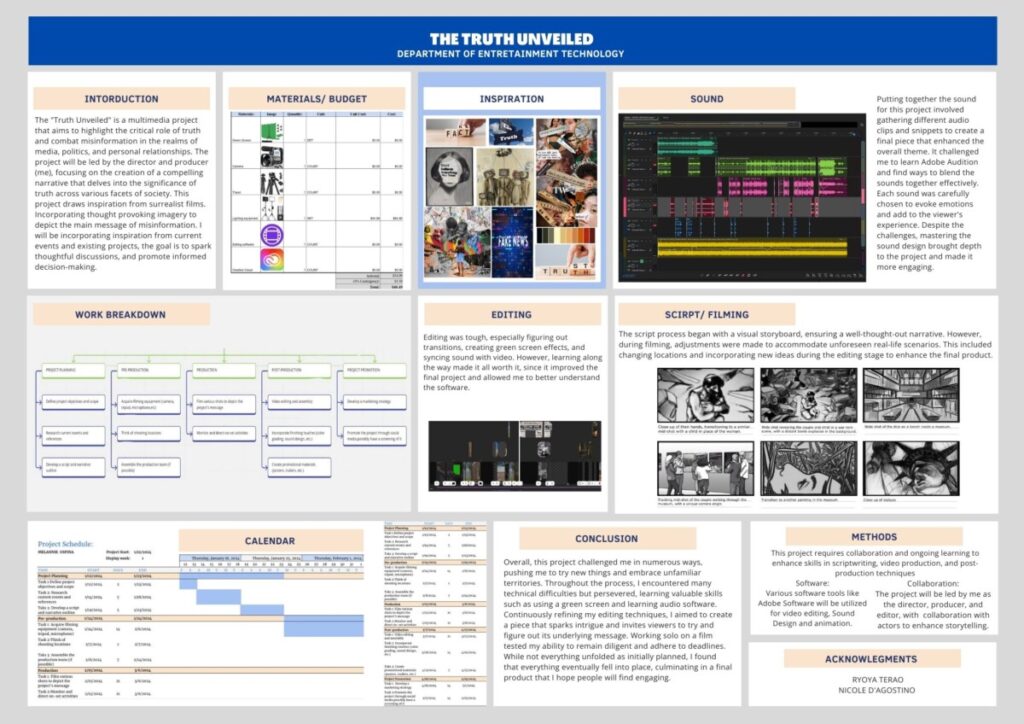https://youtu.be/RTdxPtTNGuA
PROGRESS REPORT #1
The first progress report for my film project “Truth Unveiled” focused on the beginning stages of its creation. During this phase, I completed the storyboard and the shot list for the various scenes I planned to film. These visual guides were crucial for mapping out the narrative and ensuring that each scene would effectively convey the story I wanted to tell. By having a clear plan, I could visualize how the film would unfold and make necessary adjustments before the actual filming began.
I also started developing the overall concept for the project, which involved extensive planning for the locations where I intended to shoot. This included researching and selecting suitable filming sites and acquiring the necessary materials, such as a green screen, which would be essential for certain scenes. This preparatory work was vital to ensure a smooth production process and to avoid any unexpected challenges during filming. By securing the right materials and planning the locations, I laid a solid foundation for the project.
Additionally, I finalized the software I would use for editing and post-production, which included programs like Adobe Premiere Pro. I also completed the concept and mood board for the film, which helped define the visual and emotional tone of “Truth Unveiled.” This mood board served as a reference point to maintain consistency in the film’s aesthetic and atmosphere. Overall, these initial stages were about setting up a strong framework for the project, ensuring that all elements were thoughtfully planned and ready for execution.
PROGRESS REPORT #2
The second progress report for my film “Truth Unveiled” showed a lot of progress, especially with the audio design and initial filming. I used Adobe Audition to create the audio design, which helped guide the visuals for the movie. I carefully chose and arranged different existing sound files to make a thought-provoking soundtrack. I included songs like “Clothes are So Obnoxious” by Annie Tracy, which talks about honesty, and “Everest” by Labrinth. I also added various audio clips from news and online videos to add depth to the story.
In this stage, I also planned and set up the first shoot. Coordinating everyone’s schedules was tough, but we managed to start filming a key scene at the Metropolitan Museum of Art. This location was perfect because it matched the film’s themes well. After filming, I put the footage into Adobe Premiere Pro to begin assembling the movie, making sure the scenes fit with the audio design and overall vision.
The panelists gave me helpful suggestions to improve the film’s introduction. They pointed out that the opening needed to be slower and engaging, so I kept this in mind for the final editing. This feedback was important as it helped me make the story more captivating right from the start. Overall, this progress report showed major advancements in both the audio and visual parts of the project, paving the way for further development and refinement
PRESENTATION
REFLECTION
When I first pitched the idea of creating a film to my advisor, Ryoya, I was very excited. My original concept was large and ambitious, but Ryoya suggested that I scale it down to make it manageable since I was the only person working on the project. This advice was incredibly helpful and led me to create “Truth Unveiled,” a shorter film with a powerful message.
In the first progress report for “Truth Unveiled,” I focused on the initial stages of the project. I completed the storyboard and shot list for the various scenes I planned to film. These visual guides were essential for planning the narrative and ensuring that each scene would effectively tell the story. Having a clear plan allowed me to visualize the film and make adjustments before filming began. This detailed planning gave me confidence and direction.
I also developed the overall concept for the film, which involved extensive planning for the locations I wanted to shoot. I researched and selected suitable filming sites and acquired necessary materials, like a green screen. This preparation was crucial to ensure a smooth production process and to avoid unexpected challenges. Securing the right materials and planning the locations helped lay a solid foundation for the project. Additionally, I decided on the software I would use for editing and post-production, including Adobe Premiere Pro and Adobe After Effects. I also created a concept and mood board for the film to define its visual and emotional tone, ensuring consistency throughout the project.
To keep myself on track with production, post-production, and promotion, I created a detailed calendar. This schedule was essential for managing my time and ensuring that each stage of the project stayed on track. The calendar helped me balance the different phases of the film, from initial planning to final promotion.
In the second progress report, I made significant progress, especially with the audio design and initial filming. I used Adobe Audition to create the audio design, which guided the visuals for the movie. I selected and arranged various sound files to create a thought-provoking soundtrack. I included songs like “Clothes are So Obnoxious” by Annie Tracy, which discusses honesty, and “Everest” by Labrinth. I also added audio clips from news and online videos to add depth to the story.
I also planned and set up the first shoot, which took place at the Metropolitan Museum of Art. Coordinating schedules was challenging, but we managed to start filming a key scene. The location was perfect for the film’s themes. After filming, I used Adobe Premiere Pro to begin assembling the movie, making sure the scenes fit with the audio design and overall vision. I also used LeiaPix to create animations and InShot for further editing.
Despite careful planning, I encountered challenges with the green screen, which required a reshoot. Staying on schedule was difficult, but the calendar helped me stay on track. Additionally, I lost some footage, which was frustrating, but I worked with what I had and adjusted my plans accordingly. The panelists gave me helpful suggestions to improve the film’s introduction, noting that the opening needed to be more engaging. This feedback was important and helped me make the story more captivating from the start.
Overall, the progress reports reflect a journey of careful planning, creative exploration, and overcoming practical challenges. Each step, from pitching the initial idea to Ryoya to receiving feedback from the panelists, has been a learning experience. The initial stages focused on setting up a strong framework, while the subsequent phases involved refining the audio and visual elements of the project. Despite the obstacles, I stayed on track with the schedule, and the project has been both demanding and rewarding. I gained valuable technical skills and a deeper understanding of storytelling and film production. “Truth Unveiled” is a testament to the importance of planning, adaptability, and perseverance in creative projects.



